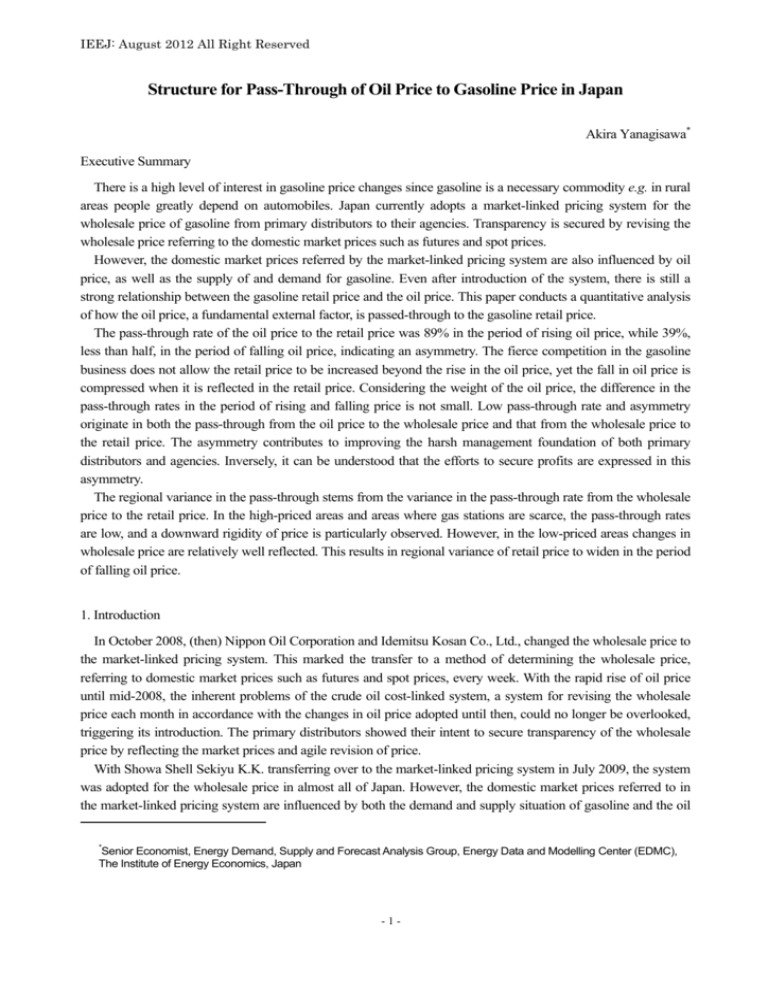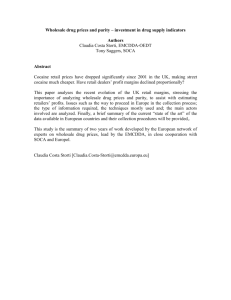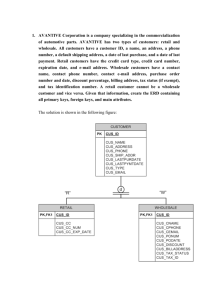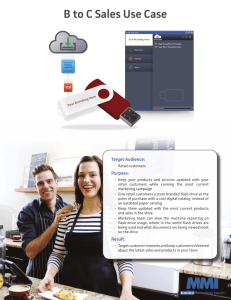
IEEJ: August 2012 All Right Reserved
Structure for Pass-Through of Oil Price to Gasoline Price in Japan
Akira Yanagisawa*
Executive Summary
There is a high level of interest in gasoline price changes since gasoline is a necessary commodity e.g. in rural
areas people greatly depend on automobiles. Japan currently adopts a market-linked pricing system for the
wholesale price of gasoline from primary distributors to their agencies. Transparency is secured by revising the
wholesale price referring to the domestic market prices such as futures and spot prices.
However, the domestic market prices referred by the market-linked pricing system are also influenced by oil
price, as well as the supply of and demand for gasoline. Even after introduction of the system, there is still a
strong relationship between the gasoline retail price and the oil price. This paper conducts a quantitative analysis
of how the oil price, a fundamental external factor, is passed-through to the gasoline retail price.
The pass-through rate of the oil price to the retail price was 89% in the period of rising oil price, while 39%,
less than half, in the period of falling oil price, indicating an asymmetry. The fierce competition in the gasoline
business does not allow the retail price to be increased beyond the rise in the oil price, yet the fall in oil price is
compressed when it is reflected in the retail price. Considering the weight of the oil price, the difference in the
pass-through rates in the period of rising and falling price is not small. Low pass-through rate and asymmetry
originate in both the pass-through from the oil price to the wholesale price and that from the wholesale price to
the retail price. The asymmetry contributes to improving the harsh management foundation of both primary
distributors and agencies. Inversely, it can be understood that the efforts to secure profits are expressed in this
asymmetry.
The regional variance in the pass-through stems from the variance in the pass-through rate from the wholesale
price to the retail price. In the high-priced areas and areas where gas stations are scarce, the pass-through rates
are low, and a downward rigidity of price is particularly observed. However, in the low-priced areas changes in
wholesale price are relatively well reflected. This results in regional variance of retail price to widen in the period
of falling oil price.
1. Introduction
In October 2008, (then) Nippon Oil Corporation and Idemitsu Kosan Co., Ltd., changed the wholesale price to
the market-linked pricing system. This marked the transfer to a method of determining the wholesale price,
referring to domestic market prices such as futures and spot prices, every week. With the rapid rise of oil price
until mid-2008, the inherent problems of the crude oil cost-linked system, a system for revising the wholesale
price each month in accordance with the changes in oil price adopted until then, could no longer be overlooked,
triggering its introduction. The primary distributors showed their intent to secure transparency of the wholesale
price by reflecting the market prices and agile revision of price.
With Showa Shell Sekiyu K.K. transferring over to the market-linked pricing system in July 2009, the system
was adopted for the wholesale price in almost all of Japan. However, the domestic market prices referred to in
the market-linked pricing system are influenced by both the demand and supply situation of gasoline and the oil
*
Senior Economist, Energy Demand, Supply and Forecast Analysis Group, Energy Data and Modelling Center (EDMC),
The Institute of Energy Economics, Japan
-1-
IEEJ: August 2012 All Right Reserved
price. As a result, even after the introduction of the market-linked pricing system, and even after the partial
review of the system made in the first half of FY 2010, there is still a strong relationship between the gasoline
retail price and the oil import price (Fig. 1-1).
Fig. 1-1. Gasoline retail price and oil import price
200
(Yen/litre)
150
Introduction of
market-linked pricing system
Gasoline retail price
Provisional abolishment of
temporary tax
100
Oil import price
50
0
2006
Note:
Source:
2007
2008
2009
2010
2011
Retail gasoline price: regular gasoline, shop price, including consumption tax, nationwide,
survey conducted on Monday; Oil import price: CIF, monthly average
Gasoline: “General Retail Price Survey,” The Oil Information Centre, The Institute of
Energy Economics, Japan (IEEJ); Oil: “EDMC Energy Trend,” The Energy Data and
Modelling Centre, IEEJ
In the medium-to-long term, if the crude oil cost is not passed-through in an appropriate manner, there will be
a risk of the system to supply gasoline becoming unsustainable. Under these situations, the fluctuations in
gasoline retail price are often observed and explained in connection with oil prices. Major newspapers have
reported the following:
Mainichi Shimbun: “…The range of fall has decreased reflecting the bottoming out of international oil
prices…”1
Yomiuri Shimbun: “…The cause of the fall in price is considered to be the stagnant domestic demand and the
fall in overseas oil prices...”2
Asahi Shimbun: “…Because oil prices fell with future uncertainties in European finance and the US
economy…”3
Nihon Keizai Shimbun: “…It marked its lowest figure in the past seven months with the sudden fall in
international oil prices at the end of September…”4
There is a high level of interest in price fluctuation since gasoline is a necessary commodity e.g. in rural areas
people greatly depend on automobiles. In this situation, some consumers complain that while the price rises
1
2
3
4
“Gasoline prices fall for 11 consecutive weeks,” Mainichi Shimbun, 27 Oct. 2011
“Gasoline prices fall for 10 consecutive weeks,” Yomiuri Shimbun, 20 Oct. 2011
“Gasoline prices fall again” Asahi Shimbun, 6 Oct. 2011.
“Price fall in gasoline prices widens,” Nihon Keizai Shimbun, 6 Oct. 2011.
-2-
IEEJ: August 2012 All Right Reserved
quickly when oil price goes up, it does not come down as fast when it falls. On the other hand, the gas stations
are distressed by the fact that it is difficult to pass-through the increase in purchase cost to the retail price.
This paper therefore focuses on the relationship between the gasoline price and the oil price, a fundamental
external factor for the gasoline price, in Japan. In other words, a quantitative analysis is conducted on how the oil
import price is passed-through to the gasoline retail price after introduction of the market-linked pricing system.
2. Pass-through of Oil Import Price to Gasoline Retail Price
An orthodox method of observing a quantitative relationship between the oil import price5 and gasoline retail
price 6 is regression analysis of the latter by the former. However, the possibility of both prices being
non-stationary is inferred. This being the case, the regression between the price levels provides spurious
correlation and could prevent accurate analysis. To avoid this, differences from the previous month for both
series are taken to make them stationary and a regression analysis is performed between the series of differences,
i.e., as pass-through relationship. Other independent variables – the amount of domestic gasoline sales7 and
amount of gasoline stock at the beginning of the period8 that indicate the supply and demand balance situation in
the upper stream of distribution, as well as the amount of gasoline purchased per household9 which are taken as
the proxy variable for retail market conditions. Consideration is also given to the possibility that pass-through is
asymmetric (the degree of pass-through differs depending on periods of rising and falling price). The model used
is as follows:
1
1
l 0
l 0
Retail price t l maxOil price t l ,0 l min Oil price t l ,0
w Amount of domestic sales t
(1)
s Amount of stock at the beginning of the period t
r 12 Amount of gasoline purchased per household t 1 e ECTt 1 ut
where is the change from the previous month, 12 is the year-on-year change, ECT is the error correction
term (deviations from medium- to long-term equilibrium values) and u is the residuals. and indicate
the pass-through rates to the gasoline price when the oil price rises or falls, respectively.
The regression period was determined to be from January 2009, when the market-linked pricing system was
beginning to permeate, to September 2011.
As a result, the pass-through rate of the oil price to the retail price was estimated at 89%10, less than full
5
6
7
8
9
10
“EDMC Energy Trend,” The Energy Data and Modelling Center, IEEJ. CIF, yen denominated, monthly average; hereinafter
“oil price.”
“General Retail Price Survey,” The Oil Information Center, IEEJ. Regular gasoline, shop price, excluding gasoline tax and
consumption tax, nationwide, monthly average of Monday surveys; hereinafter “retail price.”
“Resources and Energy Statistics,” METI. The amount of domestic sales volume is the amount sold to the wholesale and
retail business by petroleum product manufacturers and importers. Seen from the downstream of distribution, this equals
the sum of the amount sold to the final consumer and stock changes in distribution.
“Resources and Energy Statistics,” METI
“Family Income and Expenditure Survey,” households with two or more members, Statistics Bureau, Ministry of Internal
Affairs and Communications
In this model, changes in gasoline retail price are explained by changes of oil price in the relevant month and the previous
month. This being the case, the period of rising price is when oil prices increased for two consecutive months. The same
applies to the period of falling price.
-3-
IEEJ: August 2012 All Right Reserved
pass-through (100% pass-through rate) in the period of rising oil price11 and 39% in the period of falling oil
price; much less than in the period of rising price12. This indicates that pass-through is asymmetric. The severe
situation of the gasoline business does not allow the retail price to rise above the rise in oil price. However, when
the oil price falls, the amount of fall is reduced in the retail price. Considering the weight of the crude oil cost in
the retail price (Fig. 2-1), the difference in pass-through rates in the periods of rising and falling price is not
small.
Fig. 2-1. Cost structure of gasoline retail price (including tax)
(September 2011, average)
Crude oil costs
(oil imports, and
petroleum and
coal tax)
56
0
20
40
DistriRefining
bution
margin
margin
17
13
60
Gasoline tax and
consumption tax
61
80
100
120
Retail
price
147
140
160
(Yen/litre)
Note: Petroleum and Coal Tax is 2.04 yen/litre, gasoline excise is 48.6 yen, local gasoline excise is 5.2 yen
The cause of the high pass-through rate in the period of rising price is believed to come from the fact that
business continuity is difficult unless retail prices are increased following the increase in crude oil costs. On the
other hand, the cause of retail prices not decreasing in line with the fall in oil price is believed that forces work to
secure profits and maintain management strength as much as possible. This is because gasoline is a necessary
commodity, meaning decrease in the total amount of sales is limited even if the fall in price being reduced
(gasoline demand is inelastic to price)13.
The situation that took place for a period of a little over a year from August 2009 can be introduced as a
typical example of the asymmetry of pass-through (Fig. 2-2). The oil price, which was 41 yen/litre in August
2009, gradually rose with the increase in international oil prices supported by expectations for economic
recovery. In May 2010, it reached 50 yen, but with rising concerns of the European financial crisis, it returned to
41 yen in August 2010. Though gasoline indicated a similar trend, a review of the details finds differences. While
oil price fell to the level of the previous year in August 2010, gasoline remained at 74 yen/litre and did not return
to its year-on-year level (66 yen/litre), exceeding it by about 8 yen. While the oil price, which peaked in May
2009, fell almost 9 yen, the fall in the gasoline price was just above 5 yen.
11
12
13
In standard price theory, demand will decrease by price increase. Then the equilibrium price will not increase as much as
the increase in oil price, meaning that a full pass-through will not occur. However, gasoline demand is inelastic against price,
especially in the short-term, and the effect on retail price by supply and demand adjustment is considered to be minor.
Actual change in retail price will also reflect the inventory factor, etc. described above.
However, competition among gas stations is fierce.
-4-
IEEJ: August 2012 All Right Reserved
Fig. 2-2. Retail price and oil price (August 2009 - August 2010, monthly average)
90
78.8
80
(Yen/litre)
70
65.9
-5.2
73.6
Gasoline retail price
+7.7
60
49.7
50
Oil price
-9.2
40.6
40
40.6
30
Aug.
2009
Source:
Oct.
Jan.
2010
Apr.
Aug.
Gasoline: Calculated from “General Retail Price Survey,” The Oil Information Centre, IEEJ;
Oil: “EDMC Energy Trend,” The Energy Data and Modelling Center, IEEJ
3. Decomposition of Pass-through of Oil Price to Retail Price
3-1. Subject of Analysis
So then from where do the low pass-through rate and asymmetry in the pass-through of the oil price to the
retail price come?
Of the various distribution routes of gasoline, that with the largest handling is the one that starts with the
primary distributors, going through the agencies and on to the final consumer. Though direct sales by the primary
distributors are on the increase, almost 60% of the entire sales amount is still sold through the agencies. The
pass-through of the oil price to the retail price is analysed by measuring the pass-through rate of oil price to the
gasoline wholesale price, and the pass-through rate of the gasoline wholesale price on the retail price.
Fig. 3-1. Prices subject to analysis and relevant gasoline distribution route
Crude oil
production
Primary
distributors
Oil import price
Agencies
Wholesale price
Consumers
Retail price
3-2. Pass-through of Oil Price to Gasoline Wholesale Price
The model for analysing the pass-through of the oil price to the gasoline wholesale price14 is similar to the one
used to analyse the pass-through of the oil price to the retail price, which was mentioned above. However, only
14
“Wholesale Price Survey,” The Oil Information Center, IEEJ. Without tax; hereinafter “wholesale price”
-5-
IEEJ: August 2012 All Right Reserved
the amounts of domestic sales and stock at the beginning of the period that indicate the supply and demand
situation in the upper stream of distribution are used as independent variables, apart from the oil price.
Specifically, the formula is as per formula (2).
1
1
l 0
l0
Wholesale price t l max Oil price t l ,0 l min Oil price t l ,0
w Amount of domestic sales t
(2)
s Amount of stock at the beginning of the period t ut
The explanatory power of the oil price on the wholesale price is not that high since the major reference index
of the wholesale price is the domestic market prices in the market-linked pricing system. However, it has been
estimated that, on average, 77% of rise and 69% of fall in the oil price has been passed-through to the wholesale
price. In other words, in the pass-through of the oil price to the wholesale price, there is lower pass-through with
slight asymmetry.
3-3. Pass-through of Wholesale Price to Retail Price
In the model to analyse the pass-through of the wholesale price to the retail price, the amount of gasoline
purchased per household is used to indicate the retail market situation as an independent variable other than the
wholesale price. Specifically, its formula is as follows:
1
1
l 0
l 0
Retail price t l max Wholesale price t l ,0 l min Wholesale price t l ,0
(3)
r 12 Amount of gasoline purchased per household t 1 e ECTt 1 ut
The explanatory power of the wholesale price on the retail price is substantially higher than that of the oil price
on the wholesale price. The pass-through rate in the period of rising wholesale price is 105%, exceeding full
pass-through. On the other hand, the pass-through rate in the period of falling price is only 66%; significantly
lower. This indicates that asymmetry can also be seen in the pass-through of the wholesale price to the retail
price.
3-4. Decomposition of Pass-through of Oil Price to Retail Price
From the above, the low pass-through rate and asymmetry of pass-through of the oil price to the retail price is
estimated caused in both stages i.e. the pass-through of the oil price to the wholesale price and from the
wholesale price to the retail price. Exceptionally the pass-through rate in the period of rising price from the
wholesale price to the retail price is high.
-6-
IEEJ: August 2012 All Right Reserved
Fig. 3-2. Decomposition of pass-through of oil price to retail price
120%
100%
Rising price
period
89%
80%
60%
40%
Rising price
period
105%
Rising price
period Falling price
77%
period
69%
Falling price
period
66%
Falling price
period
39%
20%
0%
Oil price to
wholesale price
Wholesale price to
retail price
Oil price to retail price
Regarding contribution to asymmetry, the pass-through of the wholesale price to the retail price is greater. On
the other hand, a somewhat large asymmetry exists in the pass-through of the domestic market prices referenced
in the market-linked pricing system to the wholesale price (see Box).
Box: Oil Price and Domestic Market Prices, Domestic Market Prices and Wholesale Price
Given the structure of the market-linked pricing system, price pass-through from the oil price to the wholesale
price can be considered in two stages: (1) the pass-through of the oil price to the domestic market prices15 and
(2) the pass-through of the domestic market prices to the wholesale price. Here, the futures price16 was used as a
proxy variable for the domestic market prices and analysed.
(1) Oil price and domestic market prices
The changes in domestic market prices are explained through the changes of oil price, amounts of domestic
sales and stock at the beginning of the period. The estimated pass-through rate was 63% in the period of rising
price and 63% in the period of falling price. Though there is no asymmetry, the pass-through rate is not high.
(2) Domestic market prices and wholesale price
The changes in the wholesale price are explained through the changes of the domestic market prices and stock
at the beginning of the period. The pass-through rate in the period of rising wholesale price was 80% In the
period of falling price it was only 60% of the rising price period, at 47%. Asymmetry is observed in the
pass-through.
From this, it can be estimated that the asymmetry in pass-through from the oil price to the wholesale price is
generated at the stage of pass-through from the domestic market prices to the wholesale price.
These asymmetries influence, for example, the structure for bearing the crude oil costs. The crude oil costs on
15
16
Strictly speaking, the term “pass-through” does not apply.
Tokyo Commodity Exchange, Inc., front month, settlement, monthly average
-7-
IEEJ: August 2012 All Right Reserved
gasoline have increased by an aggregate 3 trillion yen17 between the periods from January 2009, when oil prices
bottomed out until September 2011 (Fig. 3-3).
Fig. 3-3. Increase in gasoline expenditure by consumers and its breakdown
(Jan. 2009 - Sep. 2011 aggregate amount)
4
(Trillion Yen)
3
2
3.8
3.0
1
0.3
0
0.1
1.0
-0.7
-1
Crude oil
costs
Asymmetric Supply and Asymmetric Supply and
pass-through demand pass-through demand
factor
factor, etc.
factor
factor, etc.
Refining margin
Distribution margin
Consumer
spending
Note:
Calculated at 4.8 million kL/month
If pass-through of the oil price to the gasoline price is full (pass-through rate = 100%), the final consumer will
bear the full increase of the crude oil cost of 3 trillion yen. However, though the pass-through rate is lower than
100%, with the asymmetry (and other factors such as the supply and demand situation of gasoline) the increase
in final consumer spending is approximately 3.8 trillion yen, exceeding the crude oil cost increase. The
asymmetry in pass-through is expected to contribute to a 1.3 trillion yen rise in consumer spending by both the
pass-through of the oil price to the wholesale price and that of the wholesale price to the retail price combined18.
This is much greater even after the setoff of the effects of the fall in prices for market stagnation in the retail
market (approximately 0.7 trillion yen).
4. Pass-through Situation by Region
Reflecting the local situation, the retail prices vary significantly from region to region. For the prefectures in
the Kanto region, with fierce competition among gas stations it is sold at 3-4 yen/litre cheaper than in other parts
of the country. On the other hand, in places like Nagasaki and Kagoshima, with many separated islands where
transportation costs are high, the selling price is 7-9 yen higher than in the rest of the country.
17
In comparison to the case where the oil price has continued to remain at the January 2009 level.
18
Compare with the case in which the pass-through rates in the period of rising and falling price are identical (average for
both periods) and the pass-through is symmetric.
-8-
IEEJ: August 2012 All Right Reserved
Fig. 4-1. Retail price (October 2011 average)
95
91.9
89.6
87.2
85
79.6
79.2
79.2
79.4
a
80
87.0
86.9
82.4
Ch
ib
a
(Yen/litre)
90
78.7
Low-priced areas
Source:
e
Ka
go
sh
im
a
Na
ga
sa
ki
Sh
im
an
Sa
Nationwide
Oi
ta
ga
a
Gu
nm
Sa
ita
m
ga
w
a
Ka
Ib
ar
ak
i
75
High-priced areas
Calculated from “General Retail Price Survey,” The Oil Information Centre, IEEJ
There could also be locality existing in the pass-through of the oil price to the retail prices, in addition to the
price level. We therefore conducted an analysis on the five lowest priced prefectures in average between January
2009 and September 2011 (Ibaraki, Kagawa, Saitama, Chiba and Gunma) along with the high-priced areas
(Nagasaki, Kagoshima, Shimane, Oita and Saga). We also added the urban metropolitan areas where the amount
of sales per gas station was larger (Tokyo, Kanagawa, Aichi, Osaka and Fukuoka)19 and the less gas stations
areas (Hokkaido, Shimane, Tottori, Kochi and Yamaguchi20) with fewer gas stations per length of national routes
and prefectural routes to the subjects of analysis. Fig. 4.2 shows the results of estimation of the pass-through rate.
19
20
The average amounts of sales per gas station in these five prefectures are more than double the average in other
prefectures.
Earthquake-damaged Iwate (fifth) was removed and substituted by sixth-ranked Yamaguchi.
-9-
IEEJ: August 2012 All Right Reserved
Fig. 4-2. Decomposition of pass-through of oil price to retail price (by region)
120% Rising
period
100% 90%
80%
60%
111%
93%
76%
Falling 68%
period
49%
82% 82%
103%
87%
77%
70%
76%
67%
41%
78%
68%
68%
44%
42%
40%
22%
20%
20%
100%
93%
0%
Oil to Whlsl
whlsl
to
retail
Oil to
retail
Oil to Whlsl
whlsl
to
retail
Oil to
retail
Low-priced areas
Oil to Whlsl
whlsl
to
retail
Oil to
retail
High-priced areas
Metropolitan areas
Oil to Whlsl
whlsl
to
retail
Oil to
retail
Less gas stations
areas
Though the pass-through rate of the oil price to the retail price in the period of rising price was a little lower in
the high-priced areas, overall the rates were within the same level for all the areas. In comparison, a large
regional difference was seen from the pass-through rates in the period of falling price. While the metropolitan
areas were around the national average, at 42%, and there was a slightly higher rate of 49% in the low-priced
areas, the figures were only around the 20% level in both the high-priced and the less gas stations areas. This
being the case, it is expected that the price gap between the low-priced and high-priced areas will become more
significant in the period of falling oil price. Looking at the retail prices between August 2009 and August 2010,
the retail price in high-priced areas was slow to fall in the period of falling price and the increasing trend in the
price gap with the low-priced areas can be observed (Fig. 4-3). Inversely, the gap narrowed during the period of
rising price because the pass-through rate in the low-priced areas was relatively higher.
Fig. 4-3. Regional differences in retail prices and oil price (Aug. 2009 - Aug. 2010, monthly average)
High-priced areas
20
60
Low-priced areas
15
50
Oil price
80
70
40
10
30
20
5
Regional difference(right axis)
10
0
0
Aug.
2009
Source:
Regional difference (Yen/litre)
Retail price, oil price (Yen/litre)
90
Oct.
Jan.
2010
Apr.
Aug.
Gasoline: Calculated from “General Retail Price Survey,” The Oil Information Centre, IEEJ;
Oil: “EDMC Energy Trend,” The Energy Data and Modelling Centre, IEEJ
- 10 -
IEEJ: August 2012 All Right Reserved
In the pass-through rates by stages of distribution, that of the oil price to the wholesale price was upward of
75% for all regions in the period of rising price and around 70% in the period of falling price. On the other hand,
the pass-through rates from the wholesale price to the retail price indicated a large regional difference, especially
in the period of falling price. The regional difference in the pass-through rate of the oil price to the retail price
can be said caused by the difference in the pass-through rates of the wholesale price to the retail price.
It is interesting to note that the pass-through rate of the wholesale price to the retail price in the high-priced
areas (93%) in the increase period is lower than that for the low-priced areas (111%). The high retail prices in the
high-priced areas are not the result of a large price increase and small price decrease, but rather are characterised
more in their asymmetric nature coupled with price rigidity. This is believed to be the result of the gas stations
being small in size on average21 with little margin in management. Inversely, in the low-priced areas, with fierce
competition among the gas stations the pass-through rate might be thought to be low in the period of rising price,
but the pass-through surpasses the full pass-through rate actually. Factors such as a low-margin, high-turnover
business model in which the increase in purchase cost must be securely passed-through to the retail price for the
business to succeed, the existence of price leaders, represented by “hyper” gas stations22 could be considered to
have a strong influence on the price increase. In the low-priced areas, the pass-through rate in the period of
falling price is also relatively high (but not exceeding the pass-through rate in the period of rising price), and it
can be said that this fact reflects the changes in the wholesale price more than for other areas.
The less gas stations areas show the same tendencies as in the high-priced areas. In other words, the
pass-through rate is low in the period of falling price with large asymmetry. The scarcity of competing gas
stations could also be the backdrop of downward rigidity in price. The pass-through rate in metropolitan areas is
almost the same as the national average and no special regional differences can be noticed compared to the three
other areas.
5. Summary
The pass-through of the oil price to the gasoline retail price does not reach full pass-through, reflecting the
severe conditions of the gasoline business, and asymmetry can be observed. This means that while the
pass-through rate in the period of rising oil price is 90%, it is less than half at only 40%, in the period of falling
price. The gap of pass-through rates between the period of rising price and falling price reaches 50 percentage
points. Considering the share of crude oil cost in the retail price cost structure, this gap is not small. The low
pass-through rates and asymmetry of pass-through are understood to come from both stages in the pass-through
of the oil price to the wholesale price (pass-through of the domestic market prices to the wholesale price for
asymmetry, to be more exact) and in the pass-through of the wholesale price to the retail price.
The regional difference in pass-through is caused by the difference in pass-through rate of the wholesale price
to the retail price. The pass-through rate in the low-priced areas is higher than the national average for periods of
both rising and falling price, reflecting better the fluctuation of the wholesale price relatively. Conversely, in the
high-priced areas and the less gas stations areas, the pass-through rate is low and downward price rigidity is
particularly observed. As a result, the regional difference in retail prices tends to expand in the period of falling
oil price. With improvements in the fuel economy and the fall in automobile ownership, gasoline demand is
expected to transition on a declining trend. As the shake-up of failing gas stations continues along with this trend,
21
22
The average amount of sales per gas station in high-priced areas is not only smaller than the national average, but even
smaller than the non-metropolitan region average.
Large-scale sales structure co-established in shopping malls, etc.
- 11 -
IEEJ: August 2012 All Right Reserved
there is possibility of an increase in areas where more travel will be required to refuel and at the same time, the
regional gap in prices will widen.
The relationship between the domestic market prices and the wholesale price, and the wholesale price and the
retail price, is judged quite clear. In this sense, the securing of transparency, one of the objectives of the
introduction of the market-linked pricing system, can be said to be somewhat achieved. However, consumers
may feel unconvinced by the fact that now becomes clear, that retail price rises, but do not falls, easily.
The environment surrounding the gasoline business is severe and half the petroleum sales operators are facing
losses, and the average operating profit margin is lower than the average for wholesale and retail business, at
only 0.6%23 (FY 2009). Under such a situation, the asymmetry in pass-through may be said to be contributing to
the improvement in the management foundation for both primary distributors and agencies. Inversely, it can also
be understood that efforts to secure profits are indicated in the form of asymmetry.
References
Burdette, Michael, John Zyren (2003), “Gasoline price pass-through,” U.S. Department of Energy
Chesnes, Matthew (2010), “Asymmetric pass-through in U.S. gasoline prices,” U.S. Federal Trade
Commission, working paper, no. 302
Energy Information Administration (1999), “Price changes in the gasoline market — Are Midwestern
gasoline prices downward sticky?”
Galeotti, Marzio, Alessandro Lanza, Matteo Manera (2003), “Rockets and feathers revisited: an international
comparison on European gasoline markets,” Energy Economics, vol. 25
The Oil Information Centre, The Institute of Energy Economics, Japan (2009), “Status and evaluation of new
price structure”
The Oil Information Centre, The Institute of Energy Economics, Japan (2011), “Filling station management
and structural improvement survey 2010”
Otani, Akira, Shigenori Shiratsuka, Toyoichiro Shirota (2005), “Revisiting the pass-through: further evidence
from Japan’s import prices,” Institute for Monetary and Economic Studies, discussion paper, no. 2005-E-6
Shioji, Etsuro, Taisuke Uchino (2009), “Has pass-through of exchange rate and crude oil price fluctuation
changed?,” Bank of Japan Working paper no. 09-J-8
Yanagisawa, Akira (2008), “Has the steep rise in gasoline price changed the consumption style? — Estimation
of price elasticity and evaluation of impact” Energy Economics, vol. 34, issue 1
Yanagisawa, Akira (2010), “Impact analysis on gasoline demand and CO2 emissions of the reduction in
expressway toll, free expressways and repeal of temporary tax on gasoline,” Energy Economics, vol. 36, issue 1
Ye, Michael, John Zyren, Joanne Shore, Michael Burdette (2005), “Regional comparisons, spatial aggregation,
and asymmetry of price pass-through in U.S. gasoline markets,” Atlantic Economic Journal, vol. 33
Contact: report@tky.ieej.or.jp
23
“Petroleum Products Sales Business Management Survey Report,” National Petroleum Association
- 12 -








